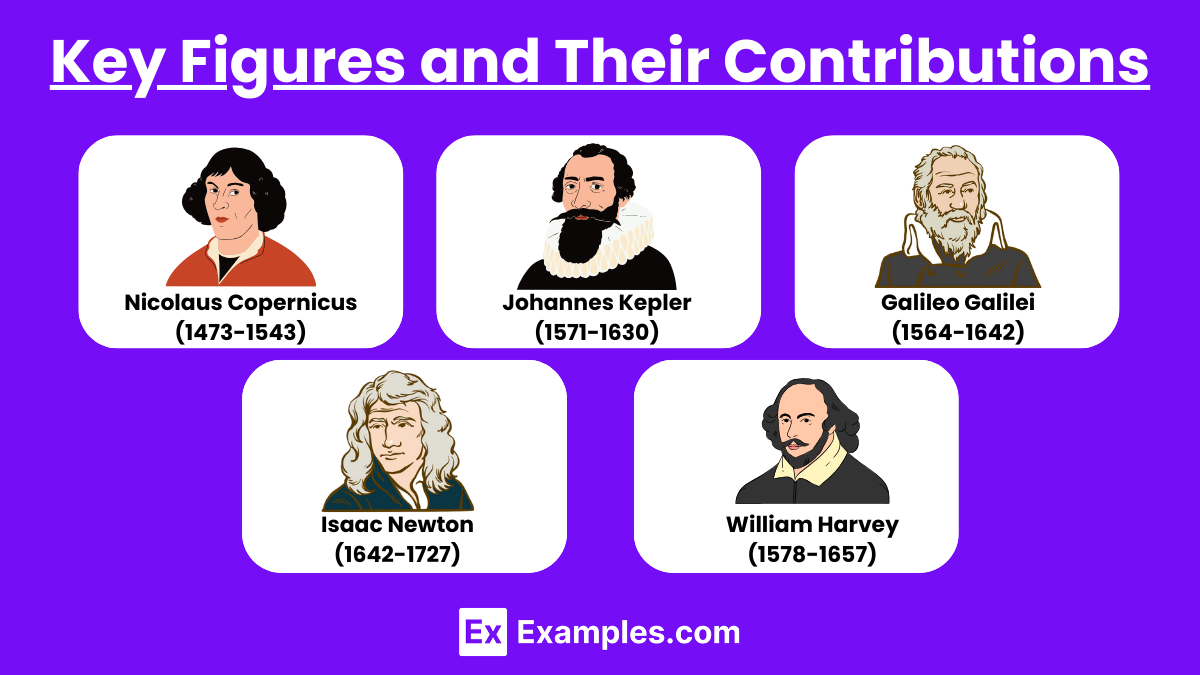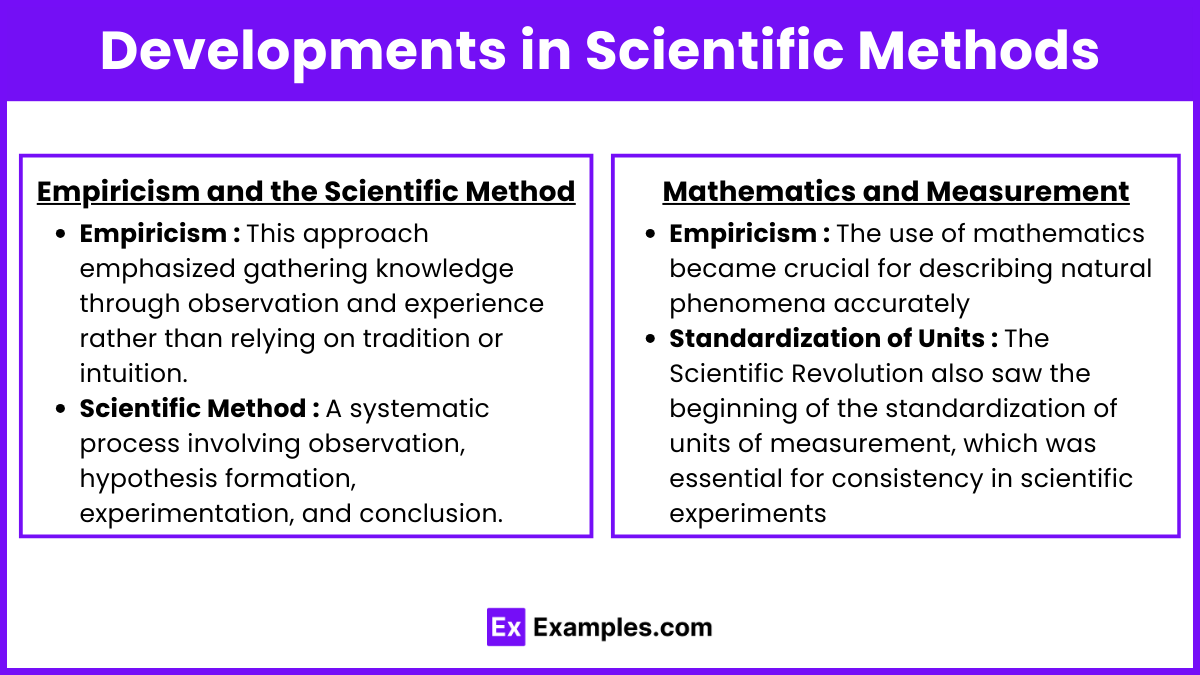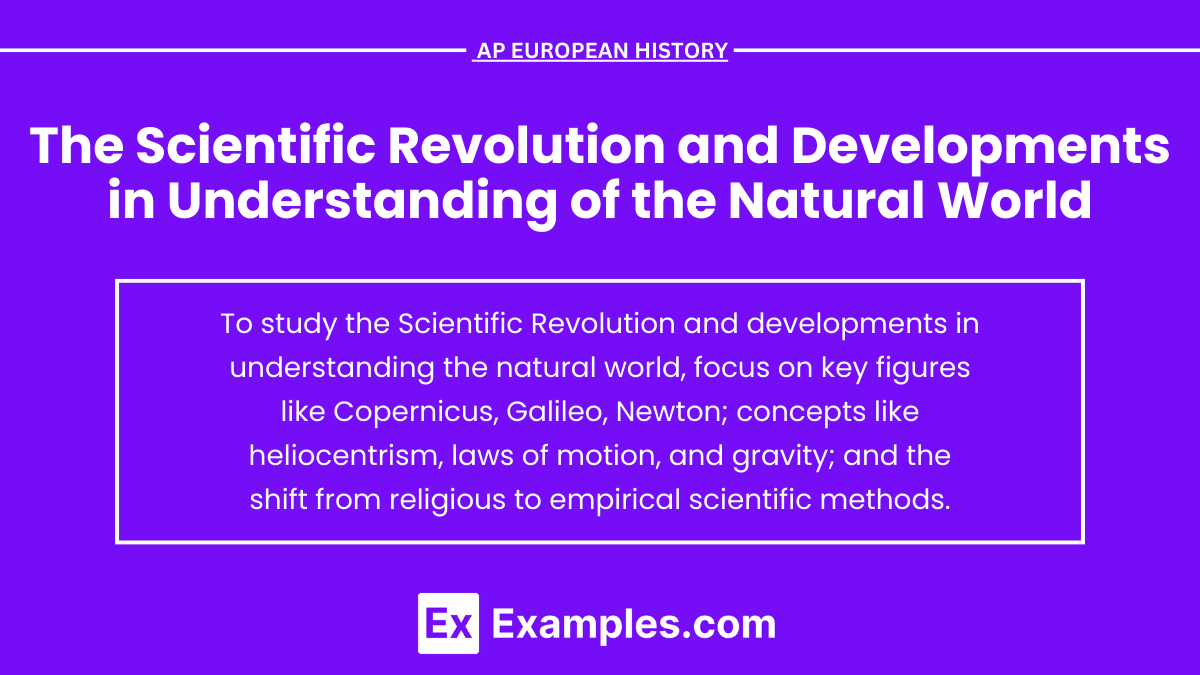The Scientific Revolution, spanning the late 16th to 18th centuries, marked a pivotal era of transformation in scientific thought and understanding. This period saw the shift from geocentric to heliocentric models of the universe, the development of the scientific method, and significant advancements in fields like astronomy, physics, and biology. Key figures such as Copernicus, Galileo, and Newton challenged traditional views, laying the foundations for modern science and profoundly influencing society, philosophy, and the natural world.
Learning Objectives
The Scientific Revolution and Developments in Understanding of the Natural World for the AP European History exam, focus on understanding the shift from geocentrism to heliocentrism, the contributions of key figures like Copernicus, Galileo, and Newton, and the development of the scientific method. Examine the impact of scientific advancements on society, religion, and philosophy, as well as the role of mathematics and empirical evidence in shaping modern science. Recognize how these developments laid the groundwork for the Enlightenment and modern scientific inquiry.
Key Figures and Their Contributions

Nicolaus Copernicus (1473-1543)
- Main Work: On the Revolutions of the Heavenly Spheres (1543)
- Contribution: Copernicus proposed the heliocentric theory, suggesting that the Sun, not the Earth, was at the center of the universe. This challenged the long-standing geocentric model that placed Earth at the center.
Johannes Kepler (1571-1630)
- Main Work: Astronomia Nova (1609)
- Contribution: Kepler formulated the laws of planetary motion, demonstrating that planets move in elliptical orbits around the Sun. His work provided mathematical support for the heliocentric theory and improved the accuracy of celestial predictions.
Galileo Galilei (1564-1642)
- Main Work: Dialogue Concerning the Two Chief World Systems (1632)
- Contribution: Galileo used a telescope to observe the heavens, discovering moons around Jupiter, sunspots, and the phases of Venus. His findings supported the heliocentric theory and challenged the Church’s teachings, leading to significant controversy.
Isaac Newton (1642-1727)
- Main Work: Philosophiæ Naturalis Principia Mathematica (1687)
- Contribution: Newton developed the laws of motion and the law of universal gravitation. These laws explained the physical principles governing both terrestrial and celestial bodies, unifying previous scientific discoveries into a coherent framework.
William Harvey (1578-1657)
- Main Work: De Motu Cordis (On the Motion of the Heart and Blood, 1628)
- Contribution: Harvey discovered the circulation of blood in the human body, describing how blood is pumped by the heart through a closed system of veins and arteries. His work was foundational in the field of physiology, challenging the prevailing theories of blood movement and significantly advancing the understanding of human anatomy and physiology.
Developments in Scientific Methods

Empiricism and the Scientific Method
- Empiricism: This approach emphasized gathering knowledge through observation and experience rather than relying on tradition or intuition. It became a foundational principle of modern science.
- Scientific Method: A systematic process involving observation, hypothesis formation, experimentation, and conclusion. This method became the standard for scientific inquiry, ensuring that findings could be replicated and verified.
Mathematics and Measurement
- Mathematical Language: The use of mathematics became crucial for describing natural phenomena accurately. Figures like Kepler and Newton used mathematical formulas to explain planetary motion and gravitational forces.
- Standardization of Units: The Scientific Revolution also saw the beginning of the standardization of units of measurement, which was essential for consistency in scientific experiments and communication. This standardization allowed scientists to accurately measure and compare data, facilitating collaboration and the sharing of results across different regions and disciplines.
Impact on Philosophy and Society
- Natural Philosophy and Mechanistic Worldview : Mechanistic View: The Scientific Revolution promoted the idea that the universe operates like a machine, governed by physical laws. This view contrasted with earlier beliefs that attributed natural events to divine intervention or mystical forces.
- Challenges to Religious and Traditional Authority : Conflicts with the Church: Many scientific discoveries of this period conflicted with religious teachings, leading to tensions between scientists and religious authorities. This period marked the beginning of a gradual separation between science and religion.
- The Enlightenment and the Spread of Knowledge: Influence on Enlightenment Thinkers: The ideas and discoveries of the Scientific Revolution inspired Enlightenment thinkers like Voltaire and Diderot, who advocated for reason, scientific inquiry, and the questioning of traditional authorities.
Examples of The Scientific Revolution and Developments in Understanding of the Natural World
- Heliocentric Theory by Nicolaus Copernicus: Copernicus proposed that the Sun, not the Earth, was the center of the universe. This heliocentric model challenged the long-held geocentric model, shifting the understanding of our solar system and inspiring further astronomical studies.
- Laws of Planetary Motion by Johannes Kepler: Kepler formulated three fundamental laws describing the motion of planets around the Sun. These laws, based on careful observations, provided a mathematical explanation for planetary orbits and laid the groundwork for Newton’s theory of gravity.
- Law of Universal Gravitation by Isaac Newton: Newton’s law explained how every mass exerts an attractive force on every other mass. This discovery not only explained why planets orbit the Sun but also revolutionized the understanding of motion and forces, integrating the heavens and Earth under the same set of laws.
- Advancements in Anatomy by Andreas Vesalius: Vesalius challenged prevailing medical theories by providing accurate and detailed descriptions of human anatomy based on dissections. His work, “De humani corporis fabrica,” corrected many misconceptions and laid the foundation for modern anatomy and physiology.
- Discovery of Microorganisms by Antonie van Leeuwenhoek: Using a microscope of his own design, Leeuwenhoek was the first to observe and describe microorganisms, which he referred to as “animalcules.” His discoveries opened a new realm of the natural world, leading to the development of microbiology and a deeper understanding of life at a microscopic level.
Practice Test Questions on The Scientific Revolution and Developments in Understanding of the Natural World
Question 1: Which of the following figures is most closely associated with the heliocentric theory, which challenged the geocentric model of the universe?
A) Isaac Newton
B) Galileo Galilei
C) Nicolaus Copernicus
D) Johannes Kepler
Answer: C) Nicolaus Copernicus
Explanation:
Nicolaus Copernicus was a Renaissance-era mathematician and astronomer who proposed the heliocentric theory, which posits that the Sun, rather than the Earth, is at the center of the universe. This theory challenged the long-held geocentric model, which placed the Earth at the center. Copernicus’s work laid the foundation for future astronomers like Kepler and Galileo to further develop and support the heliocentric model.
Question 2:The development of which scientific tool during the Scientific Revolution greatly enhanced the study of the natural world?
A) Microscope
B) Telescope
C) Barometer
D) Thermometer
Answer: B) Telescope
Explanation:
The telescope was a pivotal invention during the Scientific Revolution that allowed scientists like Galileo Galilei to observe celestial bodies in unprecedented detail. This instrument enabled the discovery of moons orbiting Jupiter, the phases of Venus, and detailed observations of the Moon’s surface, all of which provided crucial evidence against the geocentric model and supported the heliocentric theory. The telescope revolutionized our understanding of the cosmos and expanded our knowledge of the natural world.
Question 3: Which of the following scientists is known for formulating the laws of motion and universal gravitation?
A) Johannes Kepler
B) Galileo Galilei
C) René Descartes
D) Isaac Newton
Answer: D) Isaac Newton
Explanation:
Isaac Newton, an influential figure of the Scientific Revolution, formulated the three laws of motion and the law of universal gravitation. His work, published in “Principia Mathematica,” laid the groundwork for classical mechanics. Newton’s laws describe the relationship between a body and the forces acting upon it, explaining how the motion of objects changes as a result of these forces. His law of universal gravitation explained how every particle of matter in the universe attracts every other particle with a force proportional to their masses and inversely proportional to the square of the distance between them. This comprehensive theory unified the heavens and Earth under one set of physical laws.


